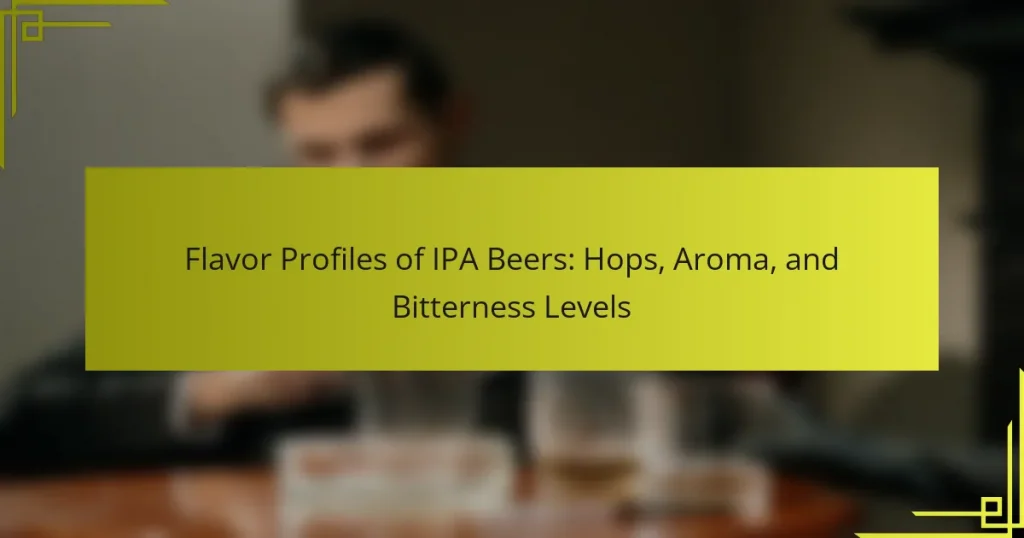IPA beers are characterized by strong hop bitterness, floral and citrus aromas, and varying malt sweetness, which create a complex tasting profile. The bitterness primarily comes from hop varieties such as Cascade, Centennial, and Citra, contributing flavors like grapefruit and tropical fruit. Different styles of IPAs, including West Coast, New England, Session, and Black IPAs, offer unique attributes that influence their flavor profiles, ranging from high bitterness to juicy fruitiness. Proper tasting and pairing techniques enhance the enjoyment of IPAs, with recommendations based on the beer’s characteristics and the intensity of accompanying foods. Research highlights the growing diversity in IPA flavors due to evolving brewing techniques and hop varieties.

What are the flavor profiles of IPA beers?
IPA beers typically feature a range of flavor profiles characterized by strong hop bitterness, floral and citrus aromas, and varying malt sweetness. The bitterness is primarily derived from the hops used during brewing, which can include varieties like Cascade, Centennial, and Citra. These hops contribute flavors such as grapefruit, pine, and tropical fruit.
The aroma of IPA beers often includes notes of resin, herbs, and spices, enhancing the overall drinking experience. Additionally, the malt backbone can provide sweetness, balancing the hop bitterness. This combination of flavors results in a complex and layered tasting profile that appeals to many beer enthusiasts.
Research by the Brewers Association indicates that the popularity of IPAs has led to an increase in hop varieties and brewing techniques, further diversifying their flavor profiles.
How do hops influence the flavor of IPA beers?
Hops significantly influence the flavor of IPA beers by imparting bitterness, aroma, and flavor complexity. The alpha acids in hops contribute to the beer’s bitterness, balancing the sweetness of the malt. This bitterness is crucial in defining the IPA style, often measured in International Bitterness Units (IBUs). Additionally, hops provide various aromatic compounds that create floral, citrus, and pine notes. These aromas enhance the overall sensory experience of the beer. Different hop varieties contribute unique flavor profiles, making each IPA distinct. Research shows that dry hopping techniques can further intensify these flavors without adding additional bitterness. The combination of these factors establishes the characteristic flavor profile of IPA beers.
What types of hops are commonly used in IPA beers?
Commonly used hops in IPA beers include Cascade, Centennial, and Citra. Cascade hops are known for their floral and citrusy aroma. Centennial hops provide a balanced bitterness with citrus and floral notes. Citra hops are celebrated for their intense tropical fruit flavors. Other hops like Simcoe and Amarillo are also popular. Simcoe offers pine and earthy characteristics, while Amarillo is known for its orange and floral aroma. These hops contribute to the distinctive flavor profiles of IPA beers.
How does the hop variety affect the aroma and bitterness?
The hop variety significantly influences both aroma and bitterness in beers. Different hop varieties contain varying levels of essential oils and alpha acids. Essential oils contribute to the aromatic profile, providing floral, citrus, or herbal notes. Alpha acids are primarily responsible for the bitterness in beer. For example, varieties like Citra and Amarillo offer strong citrus aromas and moderate bitterness. In contrast, varieties like Magnum provide high bitterness with less aromatic complexity. Studies show that the specific combination of oils and acids in each hop variety creates distinct flavor profiles. This variation impacts the overall sensory experience of the beer.
What role does aroma play in the overall experience of IPA beers?
Aroma plays a crucial role in the overall experience of IPA beers. It significantly influences the perception of flavor and enjoyment. The aroma of hops contributes to the unique scent profile of IPAs. Common notes include citrus, pine, and floral characteristics. These scents can enhance the anticipation of tasting the beer. Research shows that aroma can account for up to 80% of flavor perception. A strong aromatic profile can elevate the overall drinking experience. Thus, the aroma is essential for creating a memorable IPA experience.
What are the primary aroma characteristics found in IPA beers?
The primary aroma characteristics found in IPA beers include citrus, pine, and floral notes. Citrus aromas often feature grapefruit, orange, and lemon. Pine characteristics can evoke a resinous scent reminiscent of evergreen trees. Floral notes typically present as hints of jasmine or lavender. Additionally, some IPAs may exhibit tropical fruit aromas, such as pineapple and mango. These aroma characteristics result from the specific hops used during brewing. Popular hop varieties like Citra, Simcoe, and Amarillo contribute to these distinct scents. The combination of these aromas creates a complex and inviting profile in IPA beers.
How do brewing techniques enhance the aroma of IPA beers?
Brewing techniques enhance the aroma of IPA beers through specific methods like hop additions and fermentation practices. Dry hopping, where hops are added during fermentation, increases volatile aroma compounds. This method captures fresh hop scents that would otherwise dissipate during boiling. Additionally, using late hop additions during the boil maximizes aroma while minimizing bitterness. Temperature control during fermentation also plays a crucial role. Higher fermentation temperatures can produce fruity esters that complement hop aromas. The choice of yeast strain further influences the aroma profile. Certain yeast strains can enhance specific hop characteristics. Together, these techniques create a complex and inviting aroma in IPA beers.
What are the different bitterness levels in IPA beers?
IPA beers exhibit varying bitterness levels measured in International Bitterness Units (IBUs). Bitterness levels can range from 40 to over 100 IBUs. Session IPAs typically have lower bitterness, around 40-50 IBUs. Standard American IPAs usually feature bitterness between 50 and 70 IBUs. Double or Imperial IPAs often exceed 70 IBUs, reaching up to 100 or more. The higher the IBU, the more pronounced the bitterness in the beer. This measurement reflects the amount of hops used during brewing. Hops contribute to both bitterness and aroma, impacting the overall flavor profile.
How is bitterness measured in IPA beers?
Bitterness in IPA beers is measured in International Bitterness Units (IBUs). The IBU scale quantifies the bitterness derived from hops. Each IBU represents a specific concentration of iso-alpha acids in the beer. Typically, IPA beers range from 40 to over 100 IBUs. Higher IBU values indicate a more pronounced bitterness. This measurement is crucial for brewers to balance flavors in their recipes. The IBU scale is widely accepted in the brewing industry. It helps consumers understand the bitterness level of different beers.
What factors contribute to varying bitterness levels in IPAs?
Bitterness levels in IPAs are primarily influenced by hop variety, hop quantity, and brewing techniques. Different hop varieties contain varying levels of alpha acids, which contribute to bitterness. For example, varieties like Chinook and Columbus are known for their higher alpha acid content. The amount of hops added during brewing also affects bitterness; more hops typically increase bitterness. Additionally, the timing of hop addition plays a crucial role. Hops added during the boil contribute more to bitterness than those added during fermentation. The malt profile can also impact perceived bitterness; sweeter malts can balance hop bitterness. Finally, water chemistry, particularly mineral content, can influence bitterness perception in the finished beer.

How do different styles of IPAs affect flavor profiles?
Different styles of IPAs significantly affect flavor profiles through variations in hop selection, malt balance, and brewing techniques. For instance, West Coast IPAs are known for their strong hop bitterness and citrusy aromas. They often feature a clear, golden appearance and a dry finish. In contrast, New England IPAs are characterized by their hazy appearance and juicy, fruity flavors. They typically have a lower bitterness level and emphasize tropical fruit notes.
Session IPAs offer a lighter body and lower alcohol content, making them more refreshing while still retaining hop flavors. Black IPAs combine dark malts with hoppy characteristics, resulting in a unique blend of roasted flavors and bitterness. Each style’s distinct attributes contribute to a diverse range of taste experiences, appealing to various preferences among beer drinkers.
What are the main styles of IPA beers?
The main styles of IPA beers include American IPA, New England IPA, and West Coast IPA. American IPA is known for its strong hop flavor and bitterness. It typically has a floral and citrus aroma. New England IPA is characterized by its hazy appearance and juicy, fruity flavors. It has a lower bitterness compared to other styles. West Coast IPA features a clear appearance and a piney or resinous hop profile. It often has a higher alcohol content and a crisp finish. These styles highlight different hop characteristics and brewing techniques.
How does a New England IPA differ from a West Coast IPA in flavor?
A New England IPA (NEIPA) differs from a West Coast IPA (WCIPA) primarily in its flavor profile. NEIPAs are known for their hazy appearance and juicy, fruity flavors. They often feature tropical fruit notes such as pineapple, mango, and citrus. This results from the use of late hop additions and dry hopping techniques.
In contrast, West Coast IPAs are typically clear and have a more pronounced bitterness. They emphasize piney and resinous hop flavors, often with a citrus backbone. The hop varieties used in WCIPAs tend to be more traditional, focusing on bitterness and aroma.
The mouthfeel of NEIPAs is often softer and creamier due to higher protein content from grains. WCIPAs, however, have a drier finish and a more crisp texture. Overall, NEIPAs are fruit-forward and smooth, while WCIPAs are more bitter and aromatic.
What unique attributes do Session IPAs bring to the flavor profile?
Session IPAs bring unique attributes such as lower alcohol content and enhanced hop flavor. The alcohol by volume (ABV) typically ranges from 3% to 5%. This lower ABV allows for a more drinkable experience without sacrificing hop intensity. The hop character remains prominent, featuring citrus, pine, and floral notes. Session IPAs often showcase a balance between malt sweetness and hop bitterness. This combination results in a refreshing and vibrant flavor profile. The lighter body contributes to a crisp mouthfeel, making them ideal for extended drinking sessions. Overall, Session IPAs offer a unique blend of flavor and drinkability within the IPA category.
What impact does alcohol content have on the flavor profile of IPAs?
Alcohol content significantly influences the flavor profile of IPAs. Higher alcohol levels often enhance the body and mouthfeel of the beer. This can lead to a richer, fuller taste experience. Additionally, elevated alcohol can amplify sweetness and mask bitterness. It may also contribute to warming sensations in the palate. Conversely, lower alcohol content can result in a lighter, crisper profile. This often allows hop flavors to shine through more distinctly. Studies indicate that alcohol levels above 7% can substantially alter perceived bitterness and sweetness in IPAs.
How does higher alcohol content influence bitterness and aroma?
Higher alcohol content in beers can enhance both bitterness and aroma. Alcohol acts as a solvent for hop oils, which carry aromatic compounds. As alcohol levels increase, more of these compounds are extracted from the hops. This results in a more pronounced hop aroma. Additionally, higher alcohol can amplify perceived bitterness. The balance of sweetness from malt can shift, making the bitterness stand out more. Studies show that IPAs with higher alcohol content often exhibit stronger hop characteristics. This correlation is observed in various craft beers, where ABV (alcohol by volume) levels exceed 7%.
What are the flavor implications of lower alcohol content in IPAs?
Lower alcohol content in IPAs often results in a lighter body and more pronounced hop flavors. This is because lower alcohol levels allow the hop characteristics to shine through without being overshadowed by the malt sweetness. Additionally, the bitterness may appear more balanced, as the reduced alcohol content can enhance the perception of hop aroma and flavor. Studies indicate that IPAs with lower alcohol content can have a more refreshing quality, appealing to drinkers seeking sessionable options. The overall flavor profile tends to emphasize citrus, floral, and herbal notes, making them distinct from their higher-alcohol counterparts.

What are the best practices for tasting and pairing IPA beers?
To effectively taste and pair IPA beers, start by examining the beer’s appearance. Look for clarity, color, and head retention. Next, swirl the glass gently to release aromas. Inhale deeply to identify hop characteristics, such as citrus or pine notes. Take a small sip to assess the initial flavor and mouthfeel. Note the balance of bitterness, sweetness, and carbonation.
When pairing, consider the beer’s flavor profile. IPAs with citrus notes work well with spicy foods. Earthy IPAs complement grilled meats. Hoppy IPAs pair nicely with rich cheeses. Aim for harmony between the beer and food. This enhances both the dish and the beer’s flavors.
Research indicates that food and beer pairing can elevate the tasting experience. A study by the Brewers Association emphasizes the importance of matching intensity levels. This ensures neither the food nor the beer overpowers the other.
How can one effectively taste and evaluate an IPA beer?
To effectively taste and evaluate an IPA beer, begin by observing its appearance. Look for clarity, color, and head retention. Next, swirl the glass gently to release aromas. Inhale deeply to identify hop characteristics, such as citrus or pine notes. Take a small sip and let it coat your palate. Pay attention to the balance between malt sweetness and hop bitterness. Note the mouthfeel, whether it’s light, creamy, or harsh. Finally, evaluate the finish, considering how long the flavors linger. This methodical approach aids in a comprehensive assessment of the beer’s flavor profile.
What should be considered when assessing the aroma and bitterness?
When assessing the aroma and bitterness of IPA beers, consider hop variety and freshness. Different hop varieties impart distinct aromas, such as citrus, pine, or floral notes. Fresh hops provide a more vibrant aroma due to volatile compounds. Bitterness is measured in International Bitterness Units (IBUs), indicating the level of bitterness contributed by hops. Balance between aroma and bitterness is crucial for flavor harmony. The brewing process, including boil time and techniques, also affects both attributes. Additionally, the beer’s temperature can influence aroma perception, with warmer temperatures enhancing aromatic qualities. Understanding these factors leads to a more accurate assessment of an IPA’s flavor profile.
How can the tasting environment affect the perception of flavors?
The tasting environment significantly influences the perception of flavors. Factors such as lighting, temperature, and background noise play crucial roles. For example, dim lighting can enhance the sensory experience by creating a more intimate atmosphere. Conversely, bright lights may distract from flavor nuances. Temperature affects flavor release; warmer temperatures often enhance aroma while cooler temperatures can mute flavors. Background noise can interfere with the ability to focus on flavors, making them seem less distinct. Research indicates that environmental cues can alter taste perception, as shown in studies by Spence and Piqueras-Fiszman, which highlight how context impacts flavor experiences.
What food pairings complement the flavor profiles of IPA beers?
IPA beers pair well with spicy foods, grilled meats, and strong cheeses. The bitterness of IPAs balances spicy dishes like buffalo wings or spicy tacos. Grilled meats, such as burgers and sausages, complement the hoppy flavors. Strong cheeses, including blue cheese or aged cheddar, enhance the overall tasting experience. Additionally, citrusy IPAs work well with seafood, particularly grilled shrimp or fish tacos. These pairings create a harmonious balance between the beer’s bitterness and the food’s flavors.
What types of cuisine enhance the experience of drinking IPAs?
Spicy cuisine enhances the experience of drinking IPAs. The bitterness of IPAs complements the heat from spicy dishes. Foods like Thai curry and spicy Mexican tacos pair well with IPAs. Grilled meats also enhance the flavor profile of the beer. The caramelization in grilled foods balances the hops’ bitterness. Rich cheeses, such as blue cheese, contrast nicely with the IPA’s aroma. Fried foods, like chicken wings, provide a satisfying crunch alongside the beer. Overall, these cuisines create a harmonious tasting experience with IPAs.
How do bitterness levels influence food pairing choices?
Bitterness levels significantly influence food pairing choices. Higher bitterness in foods or beverages, such as IPAs, often pairs well with rich, fatty dishes. This is because bitterness can cut through fat, enhancing the overall flavor experience. For instance, a hoppy IPA complements fried foods and grilled meats. Conversely, lower bitterness levels suit lighter dishes, such as salads or seafood. The balance of flavors is crucial for a harmonious pairing. Studies show that the perception of bitterness can enhance the appreciation of sweet or rich flavors in food. Therefore, understanding bitterness levels aids in selecting compatible food options.
What tips can enhance the enjoyment of IPA beers?
To enhance the enjoyment of IPA beers, focus on proper glassware, temperature, and food pairings. Using a tulip or snifter glass helps concentrate aromas. Serving IPAs at 45-55°F optimizes flavor release. Pairing IPAs with spicy or savory foods complements their bitterness. Experimenting with different IPA styles can reveal unique flavor profiles. Tasting fresh IPAs within a few weeks of packaging ensures optimal freshness. Engaging in tastings with friends can enhance the experience through shared insights.
The main entity of this article is IPA beers, which are characterized by their distinct flavor profiles influenced by hops, aroma, and bitterness levels. The article provides an in-depth analysis of how various hop varieties contribute to the bitterness and aromatic characteristics of IPAs, detailing common types of hops and their unique attributes. It also explores the impact of alcohol content on flavor, the different styles of IPAs, and best practices for tasting and pairing these beers with food. Additionally, the article discusses how brewing techniques and environmental factors can enhance the overall experience of drinking IPA beers.




